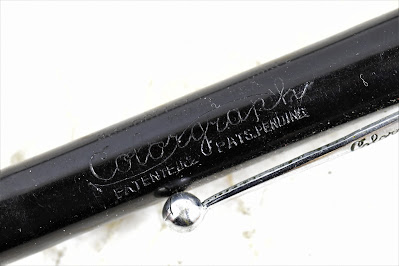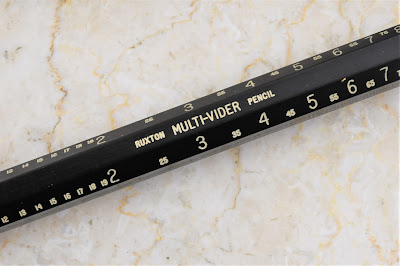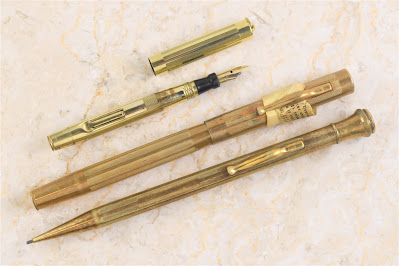This article has been included in The Leadhead's Pencil Blog Volume 7, now available here.
If you don't want the book but you enjoy the article, please consider supporting the Blog project here.
When I sit down to write one of these articles, my method of picking the topic of the day is very non-scientific: I open the file folder containing all the pictures I’ve taken, and I scroll through until I find something that I think would be fun to write about. As the more meaty subjects get pulled out and placed in the “published” file, what's left behind are the brisket tips -- good stuff, worth photographing and definitely worth noting here, but more of an appetizer than a meal. While each of these notes might not be enough for a complete article, today I'll string a few of these little notes together into a little tune.
The Colorgraph:
I haven’t written about the Colorgraph for some time, most recently in Volume 2, page 95. Since I’ve found so few of these duplex pencils over the years, it’s one of those brands I’ll chase even if I think I already have one, in the hopes there will be some tiny difference that will add to the story. Recently, I chased and caught an example in black:
Unfortunately, it was identical to my other examples (and I still haven’t found an intact earlier model, with the longer nose). So . . . all I have to tell you is that they also come in black.
The Ruxton:
The 1,000th post here at the Blog (Volume 4, page 351) covered the Ruxton well, including the company’s archive of prototype and shop models as well as production examples – including some boxed ones. I bought this one because the box was different - the other examples in my collection are dark blue with black lettering, but this one you can actually read:
The pencil is extremely clean, but unfortunately there’s nothing different about it from what I’ve shown you already:
The Welsh Manufacturing Company:
This one was in a box lot of junk that came my way, and it wasn’t my intended target.
From the clip and the nose, I knew it was made by the Welsh Manufacturing Company of Providence, Rhode Island. Here it is shown alongside other variations on the theme:
I would have just put it in the Welsh drawer without photographing it, except for one small detail:
This one has a painted wood barrel.
The “Arrow Double”:
I’d never heard of this one before:
It nearly identical to one already in my collection, with two exceptions:
First, it lacks that great arched “14kt Gold Plate” imprint on the clip:
And second, the producer’s imprint on the top is different. I say producer, because I don’t know who manufactured either one:
The one I had is an Ajax; this new one is marked “Arrow Double.” I haven’t been able to discover anything about the Arrow Double in the year since I found it.
The Bridge Set:
I had such high hopes for this next find:
This nice box contained a beautiful set of sterling pencils marked with card suits:
I wrote about a similar set in a recent article about bridge pencil sets in Volume 6, page 194. On page 196, I showed an English set by William Manton along the same lines that Joe Nemecek had given to me; it was newer than I had hoped, bearing a hallmark dating it to 1979.
This set appears to be older, and I expected hallmarks that would be a bit more . . . well, a bit more vintage than me, anyway. Alas, there are no hallmarks and it appears to have been made for export to the United States, marked only “Made in England / Sterling Silver.”
An Interesting Sheaffer Sharp Point:
This Sheaffer Sharp Point is on the early side of production, with a bowler clip and that zigzag-with-dots pattern:
What’s inside isn’t what I would expect.
The earliest Sharp Points look like this inside (see Volume 4, page 324):
While later Sheaffers (early 1920s on) look like this:
I’m not sure where this one fits in.
Cross-Built:
Here’s three very similar pencils . . . the bottom one is a typical Cross Century:
Two are marked on the clip: the Cross, and one marked “Swank.”
The Swank brand appeared in Volume 1, page 345 – on a ruler pencil/tie clip pencil. Swank, Inc., as reported in that previous article, survives as a division of Randa Accessories. The third pencil has a plain clip, but a nice imprint on the barrel:
It’s a “PAT One Twenty.” PAT was a trademark of Ketcham & McDougall, Inc., better known for making those pencils attached to a pin by a retractable chain. The company claimed to first use the mark on September 18, 1936, according to the trademark registration:
All three of these pencils share very similar features, and my suspicion is that Cross made all three. The Swank and PAT One Twenty share another element - that black plastic ring in the middle:
Welty’s
At the Krinke auction, one of my impulse buys was this fountain pen, complete with the box but with a conspicuously absent pencil:
The imprint is on the barrel, concealed under the cap when closed:
The pen was made by DeWitt-LaFrance, and I wasn’t planning on chasing it until I saw how small it was:
I wrote about the Welty’s DeWitt-LaFrance pencils in Volume 3, page 158; I came across the pen at some time since. If the matching Welty’s pencil surfaces, it would be about the smallest DeWitt-LaFrance pencil I’ve seen.
The Baby Jumbo:
The Baby Jumbo is in Volume 1, page 373, and it’s not really “mechanical.” A wood pencil is wedged in the neck of a glass bottle containing candy:
There was another example up for bids at the Krinke auction; I took “just in case” pictures of it before the auction started, because this one had the original paper label on it:
It would have been nice to bring this one home, but the pencil was identical to what I had, and the only thing the label provided was a cute admonishment to “Write your mother a letter today.” When the bidding got a little crazy on this one, I couldn’t justify spending what it would take - so my “just in case” picture will have to do!
































No comments:
Post a Comment